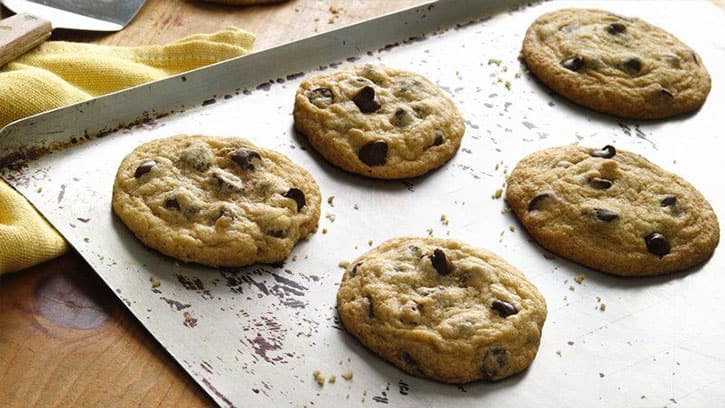
What’s the best cookie sheet to use?
Choose heavy-gauge, dull aluminum cookie sheets.
These cookie sheets (also known as baking pans) may cost a little more in the beginning. But they’re worth the investment, because heavy cookie sheets with a dull finish promote even baking and prevent overbrowning. Planning to bake lots of cookies? Get three cookie sheets: one can be baking in the oven while another is cooling off and a third is being filled with raw dough.
Choose a cookie sheet with low sides.
Or choose one with no sides at all. Cookie sheets with high sides keep your cookies from browning evenly. If you already own such a pan, don’t despair. Just turn it over. Bake your cookies on the pan’s bottom.
Choose a large cookie sheet.
We recommend buying a cookie sheet that is at least 15×12 inches. Why? Because cookies need room to spread out as they bake. Large cookie sheets let heat circulate around the dough and help prevent the cookies from connecting as they bake—which ruins their beautiful shapes.
Tip: For a huge selection of our hand-picked cookie sheets, check out the Betty Crocker Store.
Cookie Sheets to Avoid—And Why
Dark or Non-Stick Pans
Dark cookie sheets absorb extra heat – which causes cookies to burn or overbrown.
Shiny Cookie Sheets
Shiny cookie sheets reflect heat, which prevents cookies from browning evenly.
Thin Cookie Sheets
Thin cookie sheets can warp, which means they’ll heat unevenly.
Insulated Cookie Sheets
Their insulating nature causes cookies to spread before the dough sets, which creates cookies with thin edges. Insulated cookie sheets also keep cookies from browning.
Should I grease my cookie sheets?
Unless the recipe tells you to grease the cookie sheet, resist the impulse. The extra grease causes cookie dough (which already contains a lot of fat) to spread. If you’re concerned about cookies sticking, line the cookie sheet with parchment paper or a silicone non-stick mat.
Can I bake more than one batch at a time?
Cookies need to bake on the middle rack for even baking. If you can fit two pans on the middle rack without touching, you’ll get the baking results you want. If you add additional sheets of cookies on higher or lower racks, they might bake unevenly. You may save some time, but the cookies will suffer.
Do I need to cool a cookie sheet between batches?
Yes, wait until the sheet is completely cool before reusing it. Even the slightest residual heat can cause cookies to spread, making them flatter than you may want. If you need your cookie sheet to cool quickly, try one of these tricks. Stick it in the refrigerator or outside in the cool air for about five minutes. Or, run cool water over the bottom of the pan to cool it while keeping the top dry.
Why should I use parchment paper or silicone non-stick baking mats?
Parchment paper and silicone mats extend the life of your cookie sheets by preventing discoloration. Both products also make it easier to transfer delicate holiday cookies to cooking racks. Just-baked cookies can be transferred to a cooling rack on the parchment paper or mats themselves. Once cool, the cookies easily release from both materials without a fight.
BTW: What’s the difference between a cookie sheet, baking sheet, baking pan, and cookie pan?
Don’t get confused by the terminology. All these terms refer to a flat or low-sided pan for baking cookies.
Leave a Reply